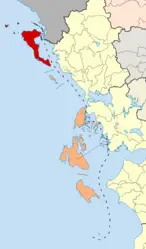The Dorians
Greek Legends about the Dorians
 According to Greek legends, the ancient people called the Dorians were named after a district in the center of Greece. The sons of Heracles, commonly known to us as Hercules, were driven from their homeland in the Peloponnese by their enemy Eurystheus of Mycenae. This event took place around 1100 BCE.
According to Greek legends, the ancient people called the Dorians were named after a district in the center of Greece. The sons of Heracles, commonly known to us as Hercules, were driven from their homeland in the Peloponnese by their enemy Eurystheus of Mycenae. This event took place around 1100 BCE.
Eurystheus and Hercules had had a long history. Due to the interference of the goddess Hera, Eurystheus had become high king instead of his cousin Hercules. Eurystheus was also responsible for giving Hercules twelve impossible labors to perform so that Hercules could atone for the murderous acts he committed on his own family. He had been driven mad by Hera.
After they had been forced out of their homeland, the sons of Hercules took refuge with the king of Doris who was called Aegimius. Several generations passed and the descendants of Hercules led the Dorian people into battle against their enemies and they regained the Peloponnese.

Historical Facts about the Dorians
The historical facts are that the Dorians (DOOR-ee-anns) most likely came from northern and northwestern Greece, which were the regions of Macedonia and Epirus. They traveled southward into central Greece. At the end of the Bronze Age, about 1100 BCE, they began several migrations to the southern Aegean area of Greece.
These invaders weren’t cultured compared to the four tribes of Ionian Greeks who were living in Greece at that time. The Dorian tribes, Hylleis, Pamphyloi, and Dymanes, could be identified by their strong dialect and their burning desire for war. In fact, their major invention was a sword made of iron and meant for slashing.
The Dorians conquered the last members of the Minoan and Mycenaean civilizations who were living in the southern part of Greece. Their rule plunged the area into a dark age. It took almost three centuries for the Greek city-states to emerge from the dominance of the Dorians.

Where the Dorians Settled
After they conquered, they spread out. They began by settling in the eastern and southern regions of Peloponnese. They created settlements in the capital of Laconia, which was Sparta. They also lived in Argolis, Messenia, and the Isthmus of Corinth. The island of Crete and the southern Aegean islands of Rhodes, Cos, Melos, and Thera became part of their domain as well.
In fact they spread out as far east as the cities of Halicarnassus and Cnidus, which is now part of southwestern Turkey.

The Second Wave of Dorian Settlers
 A second great wave of Dorian settlers began in the 8th century BCE. They spread out to the island of Corcyra, which is now known as Corfu and to Acragas, which is now known as Agrigento in Italy. Corinth, Argos, and Sparta were some of their most important cities.
A second great wave of Dorian settlers began in the 8th century BCE. They spread out to the island of Corcyra, which is now known as Corfu and to Acragas, which is now known as Agrigento in Italy. Corinth, Argos, and Sparta were some of their most important cities.
Although Doric became one of the major dialects of the classical language of Greece, very little of it remains in the modern Greek language. The reason is that the Ionic-Attic dialect of Athens began to dominate the culture and language from the 5th century BCE on.
Over time, the cultures of the Dorian people and the Ionian people blended together to influence both architecture and theater.

The Influence of the Dorians
From the 5th century BCE on, the influence of both cultures can be seen. The Dorians had power, restraint, and a desire for monuments. Coupled with the Ionian elegance and desire for ornate decoration, the resulting architecture was grand as well as graceful. In other words, the best of both cultures blended in what was to become Greek architecture. The choral lyrics used in the theater were an invention created by the Dorians.
The political power of the Dorians took another course. In the city-states that were driven by merchants and their businesses, the Dorians eventually merged with the other Greek people who had been the natives in that region. This political blending took place in Argos, Rhodes, and Corinth.
In the more warlike regions, such as Sparta and the island of Crete, the Dorians kept their power and appointed themselves the ruling military class. As with most military societies, the culture and art didn’t evolve in these regions. The ruling class kept the society under its thumb by making the native populations their agricultural slaves. The Dorians controlled the land and the natives worked it.



